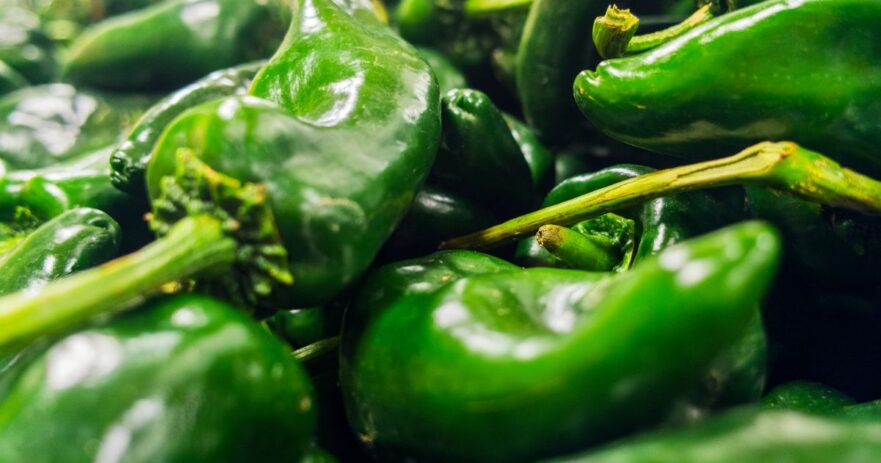In this article about Hatch chili pepper:
🗺️ Origin and history | 🌶️ Uses | ✨ Appearance and taste | 🌶️ Types | 🧑🌾 Growing – gardening | 👨🍳 Cooking – recipes | 🛒 Where to buy | 🫙 How to store | 👨⚕️ Health benefits | 🌶️ Alternatives and substitutes | ❓ Frequently asked questions
What is a Hatch chili pepper?
Hatch chili peppers are a unique and flavorful group of New Mexican chile pepper varieties cultivated in the picturesque Hatch Valley of New Mexico. Hatch chili peppers are well known for their earthy essence and scaling heat levels, making them a favorite ingredient in Southwestern and Mexican cuisines. Also known as New Mexico chiles, they’ve grown in popularity so much that the region has dedicated an annual festival to them, the Hatch chili Festival.
The chiles are often roasted to enhance their natural flavors and are commonly used in dishes like enchiladas, salsa, and chile rellenos, among other well-loved Mexican dishes. However, as their popularity grows, Hatch chilis are increasingly being incorporated into various dishes beyond traditional Southwestern and Mexican recipes, providing a tasty and unique addition to any culinary creation.
| Hatch green chile / Hatch pepper / Green Chile / New Mexico Chile | |
| SHU | 1,000 - 8,000 |
| Median SHU | 4500 |
| Flavor | Earthy, smokey, slightly sweet, and mildly spicy |
| Species | Capsicum annuum |
| Origin | Hatch Valley, New Mexico, USA |
| Uses | Roasting, grilling, salsas, sauces, etc. |
Are Hatch chili peppers spicy? How hot are they?
Hatch chili scoville: 1,000 to 8,000 SHU
Hatch chili peppers have a surprising spectrum of heat levels, with Scoville ratings ranging from 1,000 to 8,000 units. This variability in spiciness means that some Hatch chilis can be mild while others might pack quite a punch! If you’re looking to compare, jalapeños generally measure between 2,500 and 8,000 Scoville units, and bell peppers have a rating of zero, indicating no spiciness at all.
If you’re more attracted to the spicier alternatives to the Hatch, there are many other options to consider. Serrano peppers, for instance, are typically hotter than Hatch chilis, while Habanero peppers deliver an even more of a kick, with soaring Scoville ratings that can reach stifling numbers, even into the hundreds of thousands.
🗺️ ORIGIN AND HISTORY
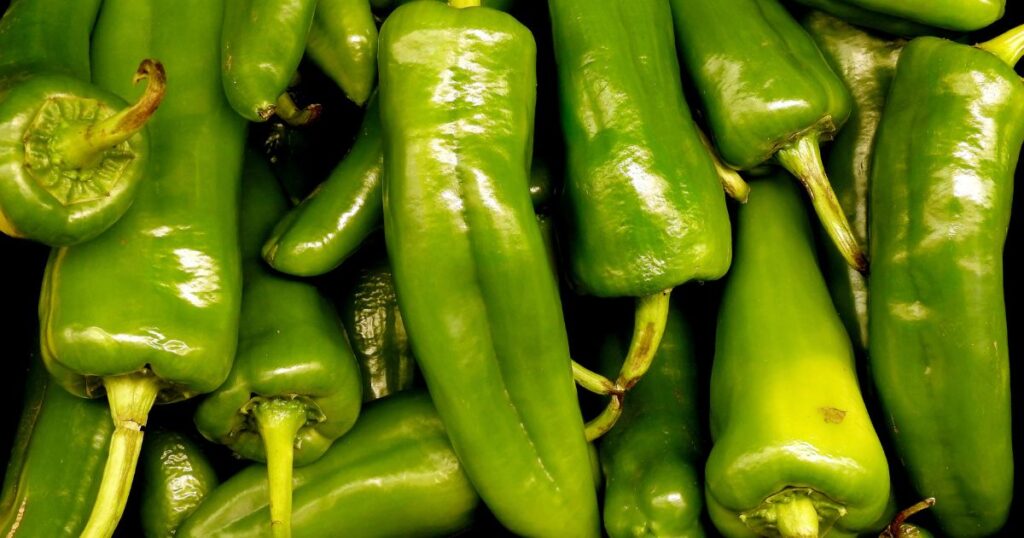
Where do Hatch chili peppers come from?
As we know, Hatch chili peppers are named after the Hatch Valley in southern New Mexico, where they were first farmed. They resulted from hybridization, blending various New Mexico chile pepper strands and varieties. Developed by horticulturist Dr. Fabián García in the early 20th century at New Mexico State University, Hatch chilis have become one of the go-to spices for New Mexican cuisine. Today, the chiles enjoy widespread popularity, not only in the United States but also in other countries around the world.
The Hatch chili Festival celebrates this popular pepper’s unique taste and heritage, and the annual turnout increases every year, showing growth in reputation and appreciation from far and wide.
🌶️ USES
What are Hatch chili peppers good for? How to use them?
Hatch chili peppers are incredibly versatile, finding their way into cookbooks and recipes worldwide. Their unique flavor profile and varying heat levels make them an ideal ingredient in many dishes, adding a distinctive taste and kick.
Green chile salsa is one of the most renowned dishes to feature a Hatch chili pepper. A spicy side to any dish, this salsa combines roasted, chopped Hatch chilis with tomatillos, onions, garlic, and cilantro (the perfect Mexican kitchen quartet). Green chile salsa is the ideal for any dish, especially when adding zest to meals like tacos, burritos, or nachos. It’s also a great condiment as a dipping sauce for chips or veggies.
When Hatch chili peppers are roasted or grilled, their natural sweetness is enhanced, and you’ll detect surprising smoky undertones. These taste sensations allow roasted Hatch chilis to be incorporated into many dishes, enhancing the flavors and creating delicious and memorable dining experiences. In addition, they elevate the flavor of soups, stews, and casseroles, adding a layer of complexity to these hearty dishes.
You can also use Hatch chili peppers to create delicious, vibrant sauces. Depending on the occasion (and your palate), these sauces can range from mild to fiery hot; it all comes down to what variety of Hatch chili you decide to use. You can drizzle the sauces over meat dishes, use them as seafood condiments, or with vegetables as sides for an extra kick.
Consider incorporating your Hatch chilis into condiments like mayonnaise or aioli, ensuring a tasty twist to sandwiches, wraps, and burgers. With so many ways to enjoy Hatch chili peppers, it’s no wonder they have become a staple in Southwestern cuisine and a beloved ingredient for heat-seeking foodies.
✨ APPEARANCE AND TASTE
What does a Hatch chili pepper look like?
Hatch chili peppers are generally quite big. One of the Hatch varieties, the Big Jim, holds the Guinness World Book of Records title for the largest chile pepper ever recorded. Typically, however, they measure between 4-6 inches and about 2-3 inches in width. Like most peppers, an ordinary Hatch chili appears in a vibrant green hue when unripe, transitioning into a deep, vibrant red as they reach full maturity. They have an elongated, tapered form that often leans into a gentle curve, adding a touch of visual intrigue to these peppers. The skin is smooth and glossy, with the occasional presence of subtle wrinkling.
What does a Hatch chili pepper taste like?
If you’re looking for a combination of rich and delightful flavors, the Hatch should be your choice of chile. They can also present a slight sweetness, ranging from mildly sweet to moderately spicy (depending on the specific variety). Their earthy, savory undertones lend a complex and well-rounded taste to any dish. The varying heat level makes them the right choice of chile for anyone, as their spiciness doesn’t box them in. The smokiness that comes from roasting the Hatch is a staple taste in Southwestern cuisine. As such, it is highly sought after and paramount in ensuring a memorable and satisfying eating experience.
🌶️ TYPES
What are the different types of Hatch chili peppers?
Because of Hatch chili peppers’ growing popularity, you will find them in more and more varieties of colors and flavors as the chile’s lifespan progresses. Each of the current varieties offers specific characteristics and features. Here, we’ll focus on two primary types: green and red Hatch chilis.
Green Hatch chilis are the most common and are typically harvested before they fully ripen, hence the green color. The bright green shade gives way to a mild to moderate heat level and (as is typical for this chile) an earthy, slightly sweet flavor. Their versatility in cooking makes them a popular choice for a wide range of dishes, including salsas, sauces, and stews.
Red Hatch chilis are the fully ripened version of the green Hatch chilis. Their vibrant red indicates a more matured, sweeter flavor and a slightly higher heat level. The more mature the chile, the hotter it becomes. You may wonder how a chile manages to be sweeter as well as spicier, but this special pepper has a range of flavors that will make your taste buds dance. Red Hatch chilis can be used similarly to their green counterparts but offer a different taste sensation, adding depth and richness to various dishes.
You will also find a few varieties of Hatch chili peppers, all of which have varying shapes, sizes, and colors. They all come with the trademark smokey, earthy aroma but have their own features. To mention a few: The NuMex Big Jim, the Barker Extra Hot, and the NuMex Sandia.
🧑🌾 GROWING – GARDENING
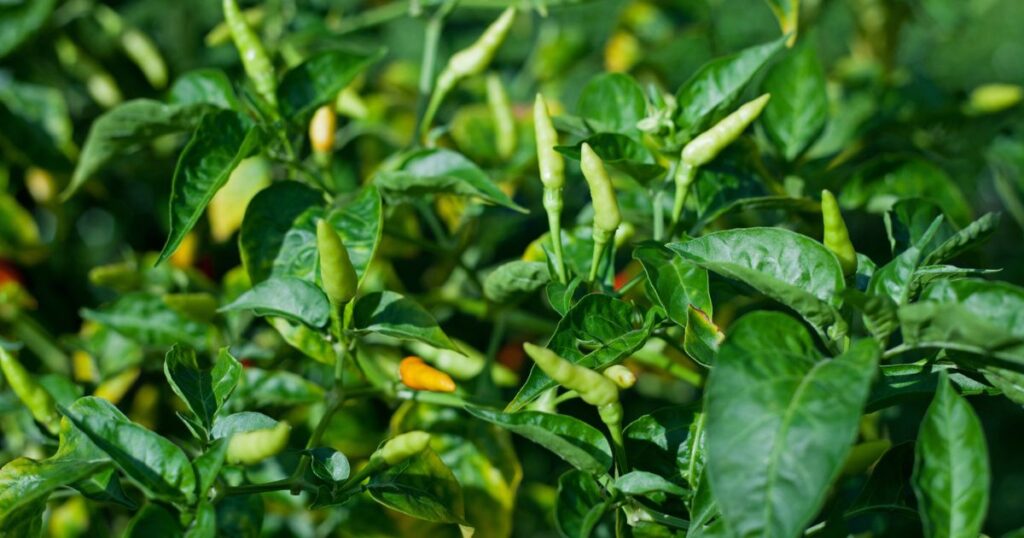
How to grow Hatch chili peppers?
No need to worry! Hatch chili peppers are relatively easy to grow, making them a familiar favorite among home gardeners and chile lovers. They can adapt to various climates but flourish best in warm conditions and abundant sunlight. Keeping in mind their specific origin, it’s important to remember that Hatch chilis are specifically from the Hatch Valley region, so if you don’t get the exact taste you’re used to – you’ll know why.
When to pick Hatch chili peppers?
These peppers can be grown either in your garden bed or in containers. They’re generally ready to be harvested within 75-90 days, provided the right care has been given to them during the chile lifecycle.
Planting Hatch chili peppers in well-draining soil and maintaining consistent watering is important for optimal growth. They also thrive with regular fertilization, particularly during their growing phase, so don’t be shy about the compost.
👨🍳 COOKING – RECIPES
Cooking/Recipe ideas for Hatch chili peppers
As we’ve mentioned, Hatch chili peppers are a favorite among home cooks and chefs. With such a versatile flavor spectrum, there really isn’t a dish that wouldn’t benefit from some form of Hatch chili accompaniment. One of the best ways to bring out the intense flavors of these peppers is by roasting them. Simply putting them on a dish and into the oven topped with olive oil brings out these roasted green chiles’ natural sweetness and smoky flavor, making them an ideal addition to various dishes.
Green chile salsa, made from fresh or roasted Hatch chili peppers, is a well-known recipe for a condiment with multiple uses. You can make it as spicy as you want by combining the peppers with ingredients like tomatoes (or tomatillos), onions, garlic, and cilantro. It’s relatively simple too. Roast your tomatillos and peppers together and then blend with the extra ingredients into a consistency of your choice. Add any herbs and spices you prefer, and voilà! If you prefer a smoother sauce, hatch green chile sauce can also be prepared by blending the peppers with onion, garlic, and a touch of stock. This sauce is excellent for drizzling over enchiladas, burritos, or huevos rancheros.
Hatch enchilada sauce is another enjoyable variation for you to test out. If you take a traditional enchilada sauce recipe and add your Hatch chilis, you can create a distinct and flavorful sauce that pairs beautifully with cheese or meat-stuffed tortillas. This sauce adds depth to the dish with its perfect heat balance and rich flavors.
What about a Hatch chili grilled cheese if you’re having a lazy day and are in the mood for something simple? Just add the roasted chile to your cheese sandwich before you fry/toast/cook it, and have the smokey, spicy flavor of the pepper complement your favorite comfort food.
Finally, for the outdoorsy types, you can grill your Hatch chili peppers on the barbeque, getting the full flavor of the pepper while enjoying the most out of mother nature at the same time. Grilling the peppers will bring out the lovely smokey flavor that makes them famous, and they can be served as a side dish or incorporated into any variety of recipes. You should also take advantage of the Hatch’s size by trying any stuffing. Fill the peppers with a combination of cheese, meat, or vegetables, and then bake or grill them until tender and delicious. So many options, and so little time!
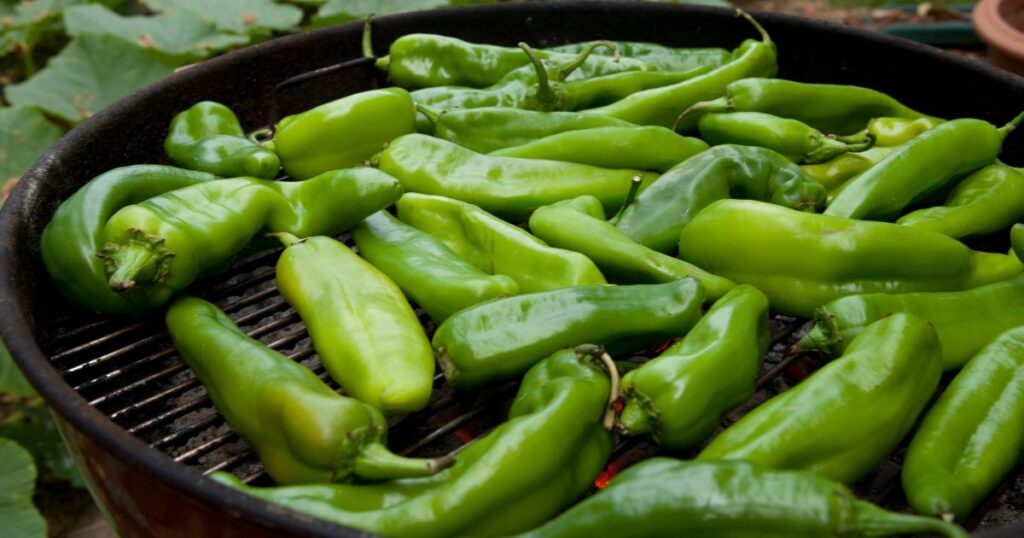
🛒 WHERE TO BUY
Where can I buy Hatch chili peppers?
Hatch chili peppers can be found at loads of grocery stores, especially during their peak season from late summer to early fall. If you can’t find them at your local supermarket, you can try checking out some specialty food stores, farmer’s markets, or even Mexican grocery stores, as they might carry these sought-after peppers. You can also order Hatch chili peppers online from various suppliers and have them conveniently shipped to your home.
Where can I buy Hatch chili pepper plants?
When choosing your perfect Hatch chili peppers, you’ll want to select the ones with the vibrant green color that are firm to the touch. Try to avoid peppers that appear soft, wrinkled, or have any sort of blemishes, as these could indicate that they are no longer fresh. If you’re interested in purchasing Hatch chili peppers in different forms, such as frozen, canned, or dried, you can usually find them in the international aisle of the grocery store.
Where can I buy Hatch chili pepper seeds?
For those wanting to grow and cultivate their own Hatch chili plants from seeds, you can find them at most garden centers or nurseries specializing in vegetable plants and seeds. When planting Hatch chili pepper seeds, be sure to follow the instructions on the seed packet and give the plants plenty of sunlight, keeping their soil well drained to ensure a successful harvest. You can also buy Hatch chili seedlings so that most of the hard work is done for you. You just need to care for the young plant.
🫙 HOW TO STORE
How do I store Hatch chilis?
Store your fresh Hatch chili peppers in the refrigerator for up to two weeks. Remember to keep them in plastic Ziploc bags or airtight containers to maintain their freshness and prevent them from deteriorating.
Can Hatch chili peppers be frozen?
Yes, they can. Hatch chili peppers can be frozen for up to six months, provided you have taken the necessary precautions to prevent the chiles from freezer burn.
- Wash and dry the peppers thoroughly.
- Remove all the stems and seeds (if you like).
- Arrange the peppers in a single layer on a baking sheet and place them in the freezer until they are fully frozen. This process usually takes a few hours.
- Once frozen, take the chiles out of the freezer and transfer them to an airtight container or a plastic freezer bag, ensuring you’ve removed as much air as possible.
From here, you can store the peppers in the freezer for up to six months. This means you can enjoy the delicious flavor in your favorite Hatch recipes, even when they are out of season.
❤️🩹 HEALTH BENEFITS
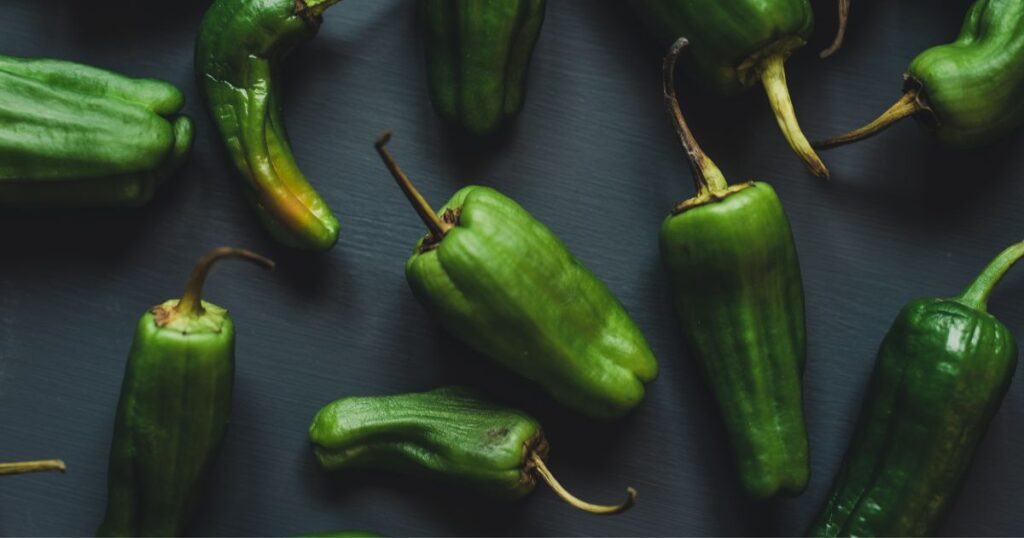
Are Hatch chili peppers healthy?
As an added extra, not only are the Hatch chili peppers delicious and a great complement to any dish, but they also offer a variety of health benefits. Low in calories and high in fiber, they’re a nutritious addition to your meals. The chiles are naturally rich in vitamin C, supporting a healthy immune system. They also contain vitamins A and B6 in higher amounts, adding to your daily vitamin intake.
As with most peppers, Hatch chili peppers contain capsaicin, a compound known for its anti-inflammatory and pain-relieving properties. Capsaicin is also the component that produces the burning sensation that we associate with the heat of the chile.
For anyone with a digestive condition or other underlying issues, it is important to be mindful that chiles can lead to gastrointestinal discomfort after consumption. If you experience any discomfort, consider reducing your intake of spicy chiles or even try avoiding them altogether to prevent further irritation.
🔄 ALTERNATIVES AND SUBSTITUTES
What is a good Hatch chili pepper alternative?
Although the Hatch chili pepper is unique in its function and flavor, you might find yourself in a place where you can’t get your hands on them and need a suitable substitute. Try testing the Hatch’s cousin, the Poblano pepper. They’re an excellent choice for anyone seeking a slightly milder flavor. However, they share the similar trademark earthy taste with which Hatch chilis are associated.
Anaheim peppers are another great alternative. They offer a parallel heat level to Hatch chilis, making them a solid substitute in various recipes. Their shape and flavor work well in dishes like stuffed peppers or salsas.
For a hotter choice, consider using jalapeño peppers. Found just about everywhere in the world, you will not struggle to get your hands on these popular peppers. They are usually spicier than Hatch chilis, but you can control the heat intensity by removing the seeds and membranes.
The even-hotter Serrano pepper can be another option for anyone seeking an even spicier substitute.
How do you pronounce Hatch chili Pepper?
Hatch chili peppers are pronounced: hach-CHEE-lee-peh-puhrs.
🙋 FREQUENTLY ASKED QUESTIONS
FAQ about Hatch chili peppers
Why are Hatch chilis special?
The Hatch Valley region in New Mexico boasts the ideal climate and soil composition to cultivate Hatch chilis. As such, they are exclusively grown there and have slightly limited availability. Of course, it helps that there is an annual harvest festival dedicated to the Hatch chili, adding only to its allure and all-around appeal.
Are hatch chili peppers spicy?
Hatch chili peppers have a spectrum of spiciness. It all depends on the specific variety and growing conditions. Although not very exact, they have a Scoville heat rating of between 1,000 and 8,000 units, placing them somewhere between mild and moderately spicy.
How to grill hatch chili peppers?
Before you grill the peppers, you should wash and dry them. Next, preheat your grill to medium-high heat. Put the whole peppers on the grill and let them cook, turning occasionally for even charring. Grill them for 10-15 minutes until the skin is blistered and charred. Once you’re satisfied with the overall look of the peppers, remove them from the grill and place them in a sealed plastic bag or covered bowl for 10 minutes to steam. This will make it easier to remove the skin. After steaming, start to peel the charred skin off. Finally, you can remove the seeds and stem and enjoy your grilled Hatch chili peppers.
Why are hatch chilis so popular?
A big contributing factor to the popularity of Hatch chilis is their distinct flavor profile, which is a direct result of the unique growing conditions in the Hatch Valley region of New Mexico. Their versatility in all cooking applications adds to their ever-growing popularity, as they can be used in a multitude of dishes, including most familiar favorites from Mexican and Southwestern cuisine. The annual Hatch chili harvest festival has also lent a hand in the growing popularity of this famous pepper, attracting visitors from far and wide. The festival does a great job of creating a sense of tradition and celebration around these flavorful peppers.
What's the difference between Hatch pepper and poblano pepper?
There are two main differences between Hatch peppers and poblano peppers. Firstly, their origin: Hatch peppers are cultivated in the Hatch Valley in New Mexico, whereas poblano peppers come from the Puebla region of Mexico. Secondly, their heat intensity: Hatch peppers tend to have a wider range of heat levels, ranging from 1,000-8,000 Scoville heat units, while poblanos are generally milder, ranging between 1,000 and 2,000 Scoville heat units.
